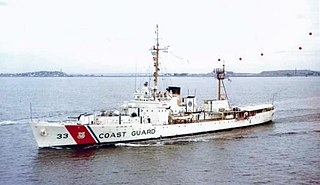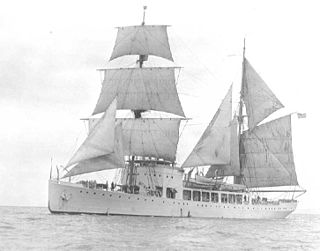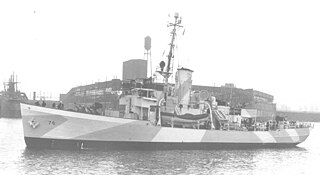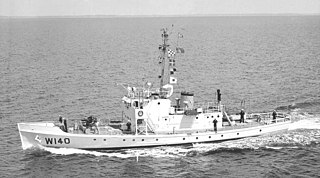
USCGC Storis (WAGL-38/WAG-38/WAGB-38/WMEC-38) was a light icebreaker and medium endurance cutter which served in the United States Coast Guard for 64 years and 5 months, making her the oldest vessel in commission with the Coast Guard fleet at the time of her decommissioning.

The USCGC Bibb (WPG-31) was a 327-foot (100 m) Secretary-Class Coast Guard ship commissioned in 1936. Seven similar "combat cutters" were built and named for secretaries of the United States Treasury. Bibb was named for U.S. Secretary of the Treasury George M. Bibb.

The Treasury-class cutter was a group of seven high endurance cutters launched by the United States Coast Guard between 1936 and 1937. The class were called the "Treasury class" because they were each named for former Secretaries of the Treasury. These ships were also collectively known as the "327's" as they were all 327 feet (100 m) in length. The Treasury-class cutters proved versatile and long-lived warships. Most served the United States for over 40 years, including with distinction through World War II, Korea, and Vietnam.

The USCGC Escanaba (WPG-77) was a 165 ft (50 m) "A" type United States Coast Guard cutter stationed on the Great Lakes from her commissioning in 1932 until the start of U.S. military involvement in World War II in 1941. With the outbreak of war, Escanaba redeployed to participate in the Battle of the Atlantic, during the course of which she was ultimately lost with nearly all hands. Struck by either a torpedo or mine in the early morning of 13 June 1943, while serving as a convoy escort, Escanaba suffered a fiery explosion and sank within minutes, leaving only two survivors and one body out of her 105-man crew to be found on the surface by rescuers.

USCGC Duane (WPG-33/WAGC-6/WHEC-33) was a cutter in the United States Coast Guard. Her keel was laid on May 1, 1935 at the Philadelphia Navy Yard, Philadelphia, Pennsylvania. She was launched on June 3, 1936 as a search and rescue and law enforcement vessel.

USCGC Tahoma (WPG-80) was a United States Coast Guard Cutter built by the Defoe Shipbuilding Company in Bay City, Michigan. Completed in 1934, the steel-hulled cutter operated on the Great Lakes between 1934 and 1941, attached to the 9th Coast Guard District and homeported at Cleveland, Ohio. She was named after the Tahoma Glacier on the western slope of Mount Rainier in the state of Washington.

USCGC Campbell (WPG-32) was a 327-foot (100 m) Secretary-class United States Coast Guard ship built at the Philadelphia Navy Yard in 1935-1936 and commissioned in 1936. Seven similar "combat cutters" were built and named for secretaries of the United States Treasury.

USCGC Escanaba (WHEC-64) was an Owasco-class high endurance cutter built for World War II service with the United States Coast Guard. The war ended before the ship was completed and consequently she never saw wartime service.

USCGC Ossipee (WPR-50) was a United States Coast Guard cutter of the Tallapoosa class constructed by Newport News Shipbuilding of Newport News, Virginia and commissioned 28 July 1915. Her hull was strengthened for light icebreaking operations. She was assigned a homeport of Portland, Maine after commissioning and cruised as far south as Cape Ann, Massachusetts serving in a law enforcement and search and rescue capacity. She saw service in both World War I and World War II.

USCGC Seneca, or before 1915 USRC Seneca, was a United States Coast Guard cutter built and commissioned as a "derelict destroyer" with the specific mission of locating and then destroying abandoned shipwrecks that were still afloat and were a menace to navigation. She was designed with excellent sea-keeping qualities, a long cruising range, good towing capabilities, and by necessity the capacity to store a large amount of munitions. She was one of five Coast Guard cutters serving with the U.S. Navy in European waters during World War I.

USCGC Northland (WPG-49) was a United States Coast Guard cruising class of gunboat especially designed for Arctic operations that served in World War II and later served in the Israeli Navy. She was the last cruising cutter built for the Coast Guard equipped with a sailing rig.
USCGC Mojave (WPG-47) was a 240-foot Tampa-class United States Coast Guard cutter in commission from 1921 until 1947.

USCGC Tampa was a United States Coast Guard Cutter that served in the United States Coast Guard from 1921 to 1941, and then in the United States Navy from 1941 to 1947.

USCGC Comanche (WPG-76) was a United States Coast Guard cutter built by Pusey & Jones Corporation, Wilmington, Delaware, and launched 6 September 1934. She was commissioned on 1 December 1934. She was used extensively during World War II for convoy operations to Greenland and as a part of the Greenland Patrol.

USCGC General Greene (WPC/WSC/WMEC-140), was a 125 ft (38 m) United States Coast Guard Active-class patrol boat, in commission from 1927 to 1968 and the fourth cutter to bear the name of the famous Revolutionary War general, Nathanael Greene. She served during the Rum Patrol, World War II and into the 1960s performing defense, law enforcement, ice patrol, and search and rescue missions.

The USCGC North Star was a United States Coast Guard Cutter during the Second World War. It was originally built for the U.S. Interior Department and served in the United States Coast Guard (USCG) before being acquired by the U.S. Navy.

The Greenland Patrol was a United States Coast Guard operation during World War II. The patrol was formed to support the U.S. Army building aerodrome facilities in Greenland for ferrying aircraft to the British Isles, and to defend Greenland with special attention to preventing German operations in the northeast. Coast Guard cutters were assisted by aircraft and dog sled teams patrolling the Greenland coast for Axis military activities. The patrol escorted Allied shipping to and from Greenland, built navigation and communication facilities, and provided rescue and weather ship services in the area from 1941 through 1945.

USCGC Saranac was a Lake-class cutter of the United States Coast Guard launched on 12 April 1930 and commissioned on 2 October 1930. After 11 years of service with the Coast Guard, she was transferred to the Royal Navy as part of the Lend-Lease Act.

USCGC Chelan was a Lake-class cutter belonging to the United States Coast Guard launched on 19 May 1928 and commissioned on 5 September 1928. After 13 years of service to the Coast Guard, she was transferred to the Royal Navy as part of the Lend-Lease Act, and named HMS Lulworth (Y60). During the war Lulworth served in a convoy Escort Group for Western Approaches Command

USCGC Legare (WSC-144) was cutter that served in the United States Coast Guard for almost forty-one years.


















